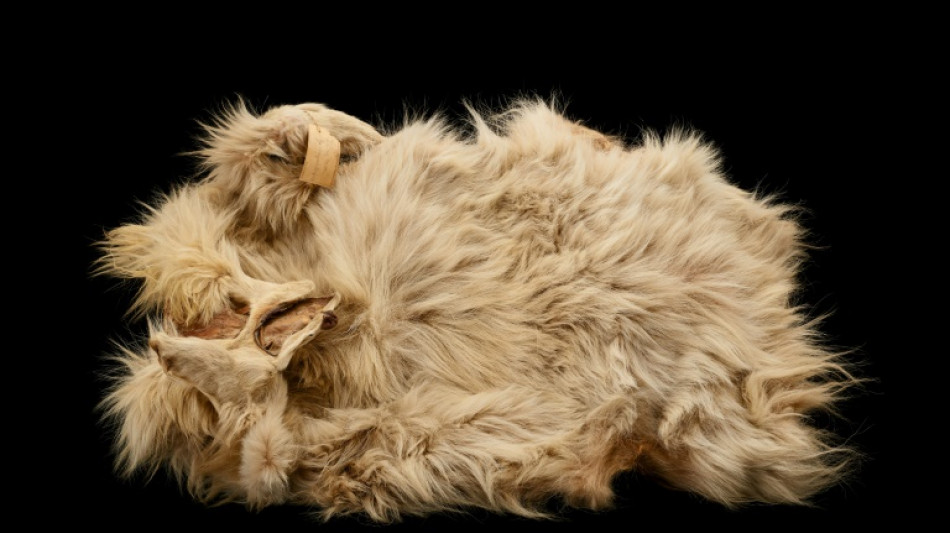
-
 Biden touts climate legacy in landmark Amazon visit
Biden touts climate legacy in landmark Amazon visit
-
Biden clears Ukraine for long-range missile strikes inside Russia

-
 'Nobody can reverse' US progress on clean energy: Biden
'Nobody can reverse' US progress on clean energy: Biden
-
Biden allows Ukraine to strike Russia with long-range missiles: US official

-
 Biden clears Ukraine for missile strikes inside Russia
Biden clears Ukraine for missile strikes inside Russia
-
Ukrainians brave arduous journeys to Russian-occupied homeland

-
 'Devil is in the details,' EU chief says of S.America trade deal
'Devil is in the details,' EU chief says of S.America trade deal
-
Toll in Tanzania building collapse rises to 13, survivors trapped

-
 'Red One' tops N.America box office but could end up in the red
'Red One' tops N.America box office but could end up in the red
-
Biden begins historic Amazon trip amid Trump climate fears

-
 Macron defends French farmers in talks with Argentina's Milei
Macron defends French farmers in talks with Argentina's Milei
-
India and Nigeria renew ties as Modi visits

-
 Typhoon Man-yi weakens as it crosses Philippines' main island
Typhoon Man-yi weakens as it crosses Philippines' main island
-
迪拜棕榈岛索菲特美憬阁酒店: 五星級健康綠洲

-
 The Retreat Palm Dubai MGallery by Sofitel: Пятизвездочный велнес-оазис
The Retreat Palm Dubai MGallery by Sofitel: Пятизвездочный велнес-оазис
-
The Retreat Palm Dubai MGallery by Sofitel: A five-star wellness Oasis

-
 Power cuts as Russian missiles pound Ukraine's energy grid
Power cuts as Russian missiles pound Ukraine's energy grid
-
Biden in historic Amazon trip as Trump return sparks climate fears

-
 India hails 'historic' hypersonic missile test flight
India hails 'historic' hypersonic missile test flight
-
Debt-saddled Laos struggles to tame rampant inflation

-
 India's vinyl revival finds its groove
India's vinyl revival finds its groove
-
Climate finance can be hard sell, says aide to banks and PMs

-
 Egypt's middle class cuts costs as IMF-backed reforms take hold
Egypt's middle class cuts costs as IMF-backed reforms take hold
-
Dinosaur skeleton fetches 6 million euros in Paris sale

-
 Trump's Republican allies tread lightly on Paris pact at COP29
Trump's Republican allies tread lightly on Paris pact at COP29
-
China's Xi urges APEC unity in face of 'protectionism'

-
 Farmers target PM Starmer in protest against new UK tax rules
Farmers target PM Starmer in protest against new UK tax rules
-
UN climate chief urges G20 to spur tense COP29 negotiations

-
 Philippines warns of 'potentially catastrophic' Super Typhoon Man-yi
Philippines warns of 'potentially catastrophic' Super Typhoon Man-yi
-
Tens of thousands flee as Super Typhoon Man-yi nears Philippines

-
 Gabon votes on new constitution hailed by junta as 'turning point'
Gabon votes on new constitution hailed by junta as 'turning point'
-
Tens of thousands flee as Typhoon Man-yi nears Philippines

-
 Is Argentina's Milei on brink of leaving Paris climate accord?
Is Argentina's Milei on brink of leaving Paris climate accord?
-
Fitch upgrades Argentina debt rating amid economic pain

-
 Trump picks Doug Burgum as energy czar in new administration
Trump picks Doug Burgum as energy czar in new administration
-
At summit under Trump shadow, Xi and Biden signal turbulence ahead

-
 Xi warns against 'protectionism' at APEC summit under Trump cloud
Xi warns against 'protectionism' at APEC summit under Trump cloud
-
Xi, Biden at Asia-Pacific summit under Trump trade war cloud

-
 Leftist voices seek to be heard at Rio's G20 summit
Leftist voices seek to be heard at Rio's G20 summit
-
Boeing strike will hurt Ethiopian Airlines growth: CEO

-
 US retail sales lose steam in October after hurricanes
US retail sales lose steam in October after hurricanes
-
Spate of child poisoning deaths sparks S.Africa xenophobia

-
 Comedian Conan O'Brien to host Oscars
Comedian Conan O'Brien to host Oscars
-
Gore says 'absurd' to hold UN climate talks in petrostates

-
 Global stocks struggle after Fed signals slower rate cuts
Global stocks struggle after Fed signals slower rate cuts
-
China tests building Moon base with lunar soil bricks

-
 Oil execs work COP29 as NGOs slam lobbyist presence
Oil execs work COP29 as NGOs slam lobbyist presence
-
Gore says climate progress 'won't slow much' because of Trump

-
 'Megaquake' warning hits Japan's growth
'Megaquake' warning hits Japan's growth
-
Stiff business: Berlin startup will freeze your corpse for monthly fee


Shaggy dog yarn: Study unravels history and demise of long-haired canine
A little-known dog lineage with fur so thick it was spun into blankets was selectively bred for millennia by Native Americans of the Pacific Northwest until its rapid demise following European colonization, a study in Science showed Thursday.
The new research was based on a genetic analysis of "Mutton," one of the last surviving Coast Salish woolly dogs whose pelt was sent to the nascent Smithsonian Institution in 1859, only to be largely forgotten until the early 2000s.
Interviews contributed by Coast Salish tribal co-authors, meanwhile, revealed the dogs occupied a previously underappreciated high-status in Indigenous societies, which revered the animals as members of the family and adorned their most treasured items with their emblem.
The dogs' fleeces were shorn like sheep, with Coast Salish weavers using the wool to craft blankets and baskets that served ceremonial and spiritual purposes.
"I was always curious about why and how the pre-colonial indigenous dogs in the Americas had gone extinct after the arrival of the Europeans," lead author Audrey Lin, a molecular biologist currently at the American Museum of Natural History, told AFP.
Where and when dogs were first domesticated remains murky, but it's clear that some of the first people who settled in the Americas brought their canine companions with them from 15,000 years ago.
Within the span of a few centuries of Western settlers, however, these breeds were all but wiped out -- and modern American dogs contain exceedingly little genetic material of their lost cousins.
- Genetic analysis -
Lin first came across Mutton when she was working as a postdoctoral researcher at the Smithsonian, and was both surprised and excited to learn that virtually no work had been done on the genetics of woolly dogs, which disappeared around the turn of the 20th century.
Based on the genetic analysis, woolly dogs diverged from other lines up to 5,000 years ago, a date that lines up with archeological findings in the region.
"We found signatures of inbreeding depression, showing that... reproduction was very carefully maintained over a very long period of time," said Lin -- echoing Native accounts that dog husbandry occurred in isolated enclosures or on coastal islands.
Mutton's own genetics showed he was 85 percent pre-colonial despite living decades after the introduction of European breeds, reinforcing the idea Indigenous people maintained the lineage's purity until the dogs were wiped out.
By analyzing 11,000 genes in Mutton's genome, the team identified 28 with links to hair growth and follicle regeneration, finding similar markers in woolly mammoths, and in humans with rare congenital abnormalities.
While Mutton's DNA told the story of his lineage, examining chemical signatures of carbon and nitrogen also offered a snapshot of Mutton the individual over his short 1.5 year life.
This revealed Mutton the pup feasted on molasses and cornmeal, but that he later turned to a hunting diet as he traveled the Pacific Northwest under the care of ethnographer George Gibbs, who was part of an expedition to solve border issues between the United States and British Canada.
- Cultural genocide-
But the story would remain incomplete without context provided by Coast Salish Elders, Knowledge Keepers and Master Weavers, whose oral histories were long ignored if not outright dismissed by Western researchers.
The dominant narrative had been Indigenous communities simply lost interest in taking care of their dogs after the advent of manufactured textiles, but co-author Michael Pavel, a Tradition Bearer of the Skokomish Indian nation, said nothing could be further from the truth.
"What we learned about was that our people encountered a very adverse section of history characterized by colonization, genocide, and assimilation -- any and every aspect of our life that associated us with our traditional culture, ceremonies and history were eradicated."
Woolly dogs were raised solely by high-ranking women, a practice that immediately raised the hackles of colonial Christian missionaries.
Moreover the smallpox brought by Europeans wiped out in some cases 90 percent of Coast Salish village populations, leaving the survivors with few resources to care for their beloved animals.
A.Zimmermann--CPN

